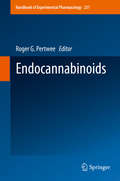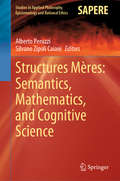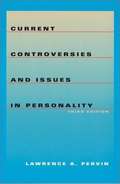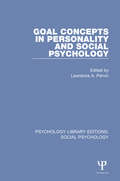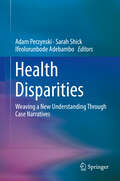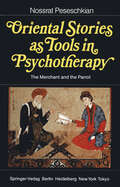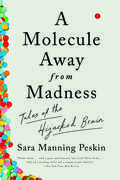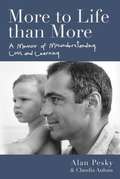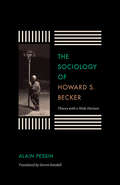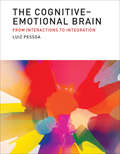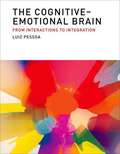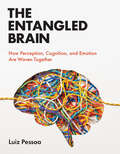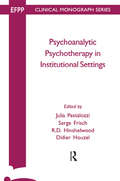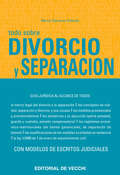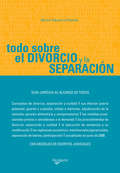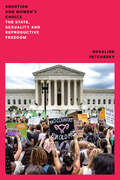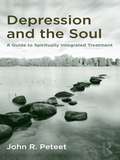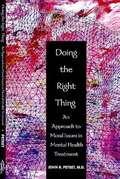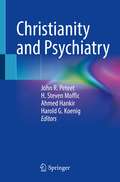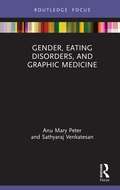- Table View
- List View
Endocannabinoids
by Roger G. PertweeThere is currently considerable interest in the development of medicines that would enhance endocannabinoid-induced "autoprotection", for example through inhibition of endocannabinoid metabolizing enzymes or cellular uptake processes or that would oppose endocannabinoid-induced "autoimpairment". This volume describes the physiology, pathophysiology and pharmacology of the endocannabinoid system and potential strategies for targeting this system in the clinic.
A Quality of Life Approach to Career Development
by Geoffrey PeruniakCareer development - the processes that shape a person's career over his or her life - is a relatively new field of research in applied psychology. In A Quality of Life Approach to Career Development, Geoffrey S. Peruniak draws from philosophy, sociology, literature, anthropology, psychology, political science, and economics to form a new, holistic approach to career development that extends beyond paid work to include all aspects of life. Emphasizing that a person is a whole entity rather than a role or category, Peruniak also explores nature and the place of community in relation to career development theories.A highly original text with broad theoretical appeal to several disciplines, A Quality of Life Approach to Career Development also includes exercises and case studies. Most importantly, this book provides a new approach that will complement more specialized methods and serve as a foundation for further study in the field.
Structures Mères: Semantics, Mathematics, and Cognitive Science (Studies in Applied Philosophy, Epistemology and Rational Ethics #57)
by Alberto Peruzzi Silvano Zipoli CaianiThis book reports on cutting-edge concepts related to Bourbaki’s notion of structures mères. It merges perspectives from logic, philosophy, linguistics and cognitive science, suggesting how they can be combined with Bourbaki’s mathematical structuralism in order to solve foundational, ontological and epistemological problems using a novel category-theoretic approach. By offering a comprehensive account of Bourbaki’s structuralism and answers to several important questions that have arisen in connection with it, the book provides readers with a unique source of information and inspiration for future research on this topic.
Current Controversies and Issues in Personality (Third Edition)
by Lawrence A. PervinIn this engaging book, Lawrence A. Pervin explores both the classic and more recent issues that define the field of personality psychology. Striking a careful balance between evolutionary and cultural perspectives, Pervin critically examines the issues that are the basis of much of the theory and research present in the field today and which are likely to be the basis for advances in the future. He presents an evenhanded coverage of current approaches to personality, and pays particular attention to the public policy implications of different theoretical views. Some of the fascinating controversies and debates you'll find in this book include: * Is Personality Stable Over the Life course? * The Nature of Human Nature: Culture and the Search for Universals * Mind, Brain, and Behavior: Psychology, Biology, and the Question of Reductionism * Is the Concept of the Self Useful and Necessary? * The Enterprise of Personality Research: How should it be Conducted?
Goal Concepts in Personality and Social Psychology (Psychology Library Editions: Social Psychology)
by Lawrence A. PervinIs behavior motivated? And if so, can it be motivated by the anticipation of future events? What role does cognition play in such motivational processes? And, further, what role does motivation play in ongoing cognitive activity? Questions such as these provide the foundation for this book, originally published in 1989. More specifically, the chapters in this book address the question of the utility of goals concepts in studying motivation and social cognition.
Theories of Personality
by Lawrence Pervin Daniel Cervone John Oliver"Why should you take a course in personality? Why are some people so taken by the field that they decide to become personality psychologists? A basic attraction of the field is that it addresses the questions "Why are people the way they are? Why am I the way I am?" We are all fascinated by such questions, and personality psychology promises to answer them. Admittedly, this text and the scientific field it reviews may not definitively answer all of your questions. Yet much scientific progress has been made in understanding persons and the differences among them. This book will introduce you to some of the answers that contemporary scientific research can provide, while also introducing you to the best and most influential theoretical frameworks that have been developed for studying people." From Chapter 1
Health Disparities: Weaving a New Understanding Through Case Narratives
by Adam Perzynski Sarah Shick Ifeolorunbode AdebamboThis uniquely accessible volume challenges professionals to understand—and help correct—health disparities, both at the patient level and in their larger social contexts. Dedicated to eradicating this ongoing injustice, contributors focus on marginalized populations, the role of healthcare systems in perpetuating inequities, the need for deeper engagement and listening by professionals, and the need for advocacy within professional education and the political/policy arena. The compelling case narratives at the core of the book illustrate the interrelated biopsychosocial components of patients’ health problems and the gradations of learning needed for practitioners to address them effectively. The book’s tools for developing a health disparities curriculum include a selection of workshop exercises, facilitator resources, and a brief guide to writing effective case narratives. A sampling of the narratives: “Finding the Person in Patient-Centered Health Care” (race/ethnicity/culture). “The Annual Big Girl / Big Boy Exchange” (gender). “Just Give Me Narcan and Let Me Go” (poverty/addiction). “Everyone Called Him Crazy” (immigration). “Adrift in the System” (disability). “Aging out of Pediatrics” (mental illness and stigma). “Time to Leave” (LGBT) A work of profound compassion, Health Disparities will be of considerable interest to researchers and practitioners interested in public health, population health, health disparities, and related fields such as sociology, social work, and narrative medicine. Its wealth of educational features also makes it a quality training text. "I was impressed when I read Health Disparities: Weaving a New Understanding through Case Narratives. As a patient who has experienced unpleasant situations in health care, I was moved to see that it was emotional and personal for the writers. The book confirms for me that the time is now for change to take place in our health care systems. I see this book as a light that can shine bright in the darkest places of health care. The editors have assembled a powerful book that provides all health professionals with specific steps they can take towards addressing and then eventually eliminating health disparities. A few steps that I really connected with were improving critical awareness, delivering quality care, listening and empathizing with patients and families, and advocating for changes. I recommend that anyone interested in working to improve health care obtain a copy of this book—it’s filled with useful information that every medical professional should know. The book reminds me of a quote by Wayne Dyer, 'When you change the way you look at things, the things you look at change.'" -Delores Collins, Founder and Executive Director, A Vision of Change Incorporated, Certified Community Health Worker. Founder of The Greater Cleveland Community Health Workers Association.
El muerto
by Franco PescePoderosa novela sobre la pérdida y el duelo de la mano de un nuevo escritor chileno. Tiago murió y ahora López relata su muerte, el momento en que su amigo se ahogó en el mar. Alguien lo escucha narrar esa escena y las que siguieron: el llamado a la familia con la noticia, el funeral sin féretro, la posible deriva del cuerpo en el agua: «En la playa seguían observando el agua, creyendo que Tiago podía vivir. No podía: había muerto». Obsesivamente y con lucidez tal vez despiadada, López repasa las esperanzas e ilusiones de los familiares y amigos del muerto desde una visión despojada de toda magia y autocompasión.
Oriental Stories as Tools in Psychotherapy: The Merchant and the Parrot
by N. PeseschkianIf you give someone a fish, you feed him only once. If you teach him how to fish, he can feed himself forever. ---Oriental wisdom When a German or American comes home in the evening, he wants his peace and quiet. That, at least, is the general rule. He sits down in front of the television, drinks his hard-earned beer and reads his newspaper, as if to say, "Leave me in peace. After working so hard, I have a right to it." For him, this is relaxation. In the East, a man relaxes in a different way. By the time he comes home, his wife has already invited a few guests, relatives, or family and business friends. By chatting with his guests, he feels relaxed, as though freely translating the motto "Guests are a gift from God." Relaxation can thus mean many things. There is no set definition for everything that relaxation comprises. People relax in the way they have learned how, and the way they hav~earned is what is customary in their family or group, or in the social circle to which they belong.
A Molecule Away from Madness: Tales Of The Hijacked Brain
by Sara Manning PeskinLonglisted for the PEN/E.O. Wilson Literary Science Writing Award Riveting stories of the brain on the brink, from an acclaimed cognitive neurologist. Our brains are the most complex machines known to humankind, but they have an Achilles heel: the very molecules that allow us to exist can also sabotage our minds. Here are gripping accounts of unruly molecules and the diseases that form in their wake. A college student cannot remember if she has eaten breakfast. By dinner, she is strapped to a hospital bed, convinced she is battling zombies. A man planning to propose marriage instead becomes violently enraged, gripped by body spasms so severe that he nearly bites off his own tongue. One after another, poor farmers in South Carolina drop dead from a mysterious epidemic of dementia. With an intoxicating blend of history and intrigue, Sara Manning Peskin invites readers to play medical detective, tracing each diagnosis from the patient to an ailing nervous system. Along the way, Peskin entertains with tales of the sometimes outlandish, often criticized, and forever devoted scientists who discovered it all. Peskin never loses sight of the human impact of these conditions. Alzheimer’s Disease is more than the gradual loss of a loved one; it can be a family’s multigenerational curse. The proteins that abound in every cell of our bodies are not simply strings of oxygen, hydrogen, nitrogen, and carbon; they are the building blocks of our personalities and relationships. A Molecule Away from Madness is an unputdownable journey into the deepest mysteries of our brains.
More to Life than More: A Memoir of Misunderstanding, Loss, and Learning
by Alan Pesky Claudia AulumAt the age of thirty, just as everything was falling into place for him, Lee Pesky died of brain cancer. For his father, Alan, grief came with the realization that he had lost the chance to love Lee as he was—not as he wanted him to be. Ambitious, successful, and always striving for more, Alan had a hard time relating to a son who struggled with learning disabilities at a time when there was little understanding or help for kids who had them. Their relationship was complicated, and now, Lee was gone.More to Life than More is a memoir of misunderstanding, loss, and learning. After Lee&’s death, Alan&’s conception of more crumbles. He launches himself into keeping Lee&’s memory alive by helping kids in a way he wasn&’t able to help his son. It was too late to change his relationship with Lee, but he could create something positive and enduring from his loss: Lee Pesky Learning Center, a non-profit in Idaho dedicated to understanding and helping those with learning differences.In 25 years, LPLC has benefited more than 100,000 children and has become a national force for early childhood literacy. And for Alan, it has meant getting to know the son he had misunderstood and lost.
The Sociology of Howard S. Becker: Theory with a Wide Horizon
by Alain Pessin Steven RendallHoward S. Becker is a name to conjure with on two continents —in the United States and in France. He has enjoyed renown in France for his work in sociology, which in the United States goes back more than fifty years to pathbreaking studies of deviance, professions, sociology of the arts, and a steady stream of books and articles on method. Becker, who lives part of the year in Paris, is by now part of the French intellectual scene, a street-smart jazz pianist and sociologist who offers an answer to the stifling structuralism of Pierre Bourdieu. French fame has brought French analysis, including The Sociology of Howard S. Becker, written by Alain Pessin and translated into English by Steven Rendall. The book is an exploration of Becker’s major works as expressions of the freedom of possibility within a world of collaborators. Pessin reads Becker’s work as descriptions and ideas that show how society can embody the possibilities of change, of doing things differently, of taking advantage of opportunities for free action. The book is itself a kind of collaboration—Pessin and Becker in dialogue. The Sociology of Howard S. Becker is a meeting of two cultures via two great sociological minds in conversation.
Ibn Gabirol's Theology of Desire
by Sarah PessinDrawing on Arabic passages from Ibn Gabirol's original Fons Vitae text, and highlighting philosophical insights from his Hebrew poetry, Sarah Pessin develops a "Theology of Desire" at the heart of Ibn Gabirol's eleventh-century cosmo-ontology. She challenges centuries of received scholarship on his work, including his so-called Doctrine of Divine Will. Pessin rejects voluntarist readings of the Fons Vitae as opposing divine emanation. She also emphasizes Pseudo-Empedoclean notions of "Divine Desire" and "Grounding Element" alongside Ibn Gabirol's use of a particularly Neoplatonic method with apophatic (and what she terms "doubly apophatic") implications. In this way, Pessin reads claims about matter and God as insights about love, desire, and the receptive, dependent, and fragile nature of human being. Pessin reenvisions the entire spirit of Ibn Gabirol's philosophy, moving us from a set of doctrines to a fluid inquiry into the nature of God and human being - and the bond between God and human being in desire.
The Cognitive-Emotional Brain: From Interactions to Integration (The\mit Press Ser.)
by Luiz PessoaA study that goes beyond the debate over functional specialization to describe the ways that emotion and cognition interact and are integrated in the brain.The idea that a specific brain circuit constitutes the emotional brain (and its corollary, that cognition resides elsewhere) shaped thinking about emotion and the brain for many years. Recent behavioral, neuropsychological, neuroanatomy, and neuroimaging research, however, suggests that emotion interacts with cognition in the brain. In this book, Luiz Pessoa moves beyond the debate over functional specialization, describing the many ways that emotion and cognition interact and are integrated in the brain. The amygdala is often viewed as the quintessential emotional region of the brain, but Pessoa reviews findings revealing that many of its functions contribute to attention and decision making, critical components of cognitive functions. He counters the idea of a subcortical pathway to the amygdala for affective visual stimuli with an alternate framework, the multiple waves model. Citing research on reward and motivation, Pessoa also proposes the dual competition model, which explains emotional and motivational processing in terms of their influence on competition processes at both perceptual and executive function levels. He considers the broader issue of structure-function mappings, and examines anatomical features of several regions often associated with emotional processing, highlighting their connectivity properties. As new theoretical frameworks of distributed processing evolve, Pessoa concludes, a truly dynamic network view of the brain will emerge, in which "emotion" and "cognition" may be used as labels in the context of certain behaviors, but will not map cleanly into compartmentalized pieces of the brain.
The Cognitive-Emotional Brain: From Interactions to Integration
by Luiz PessoaThe idea that a specific brain circuit constitutes the emotional brain (and itscorollary, that cognition resides elsewhere) shaped thinking about emotion and the brain for manyyears. Recent behavioral, neuropsychological, neuroanatomy, and neuroimaging research, however,suggests that emotion interacts with cognition in the brain. In this book, Luiz Pessoa moves beyondthe debate over functional specialization, describing the many ways that emotion and cognitioninteract and are integrated in the brain. The amygdala is often viewed as thequintessential emotional region of the brain, but Pessoa reviews findings revealing that many of itsfunctions contribute to attention and decision making, critical components of cognitive functions. He counters the idea of a subcortical pathway to the amygdala for affective visual stimuli with analternate framework, the multiple waves model. Citing research on reward andmotivation, Pessoa also proposes the dual competition model, which explainsemotional and motivational processing in terms of their influence on competition processes at bothperceptual and executive function levels. He considers the broader issue of structure-functionmappings, and examines anatomical features of several regions often associated with emotionalprocessing, highlighting their connectivity properties. As new theoretical frameworks of distributedprocessing evolve, Pessoa concludes, a truly dynamic network view of the brain will emerge, in which"emotion" and "cognition" may be used as labels in the context of certain behaviors, but will notmap cleanly into compartmentalized pieces of the brain.
The Entangled Brain: How Perception, Cognition, and Emotion Are Woven Together
by Luiz PessoaA new vision of the brain as a fully integrated, networked organ.Popular neuroscience accounts often focus on specific mind-brain aspects like addiction, cognition, or memory, but The Entangled Brain tackles a much bigger question: What kind of object is the brain? Neuroscientist Luiz Pessoa describes the brain as a highly networked, interconnected system that cannot be neatly decomposed into a set of independent parts. One can&’t point to the brain and say, &“This is where emotion happens&” (or any other mental faculty). Pessoa argues that only by understanding how large-scale neural circuits combine multiple and diverse signals can we truly appreciate how the brain supports the mind. Presenting the brain as an integrated organ and drawing on neuroscience, computation, mathematics, systems theory, and evolution, The Entangled Brain explains how brain functions result from cross-cutting brain processing, not the function of segregated areas. Parts of the brain work in a coordinated fashion across large-scale distributed networks in which disparate parts of the cortex and the subcortex work simultaneously to bring about behaviors. Pessoa intuitively explains the concepts needed to formalize this idea of the brain as a complex system and how to unleash powerful understandings built with &“collective computations.&”
Psychoanalytic Psychotherapy in Institutional Settings (The\efpp Monograph Ser.)
by Julia Pestalozzi Serge Frisch R. D. Hinshelwood Didier HouzelThis book deals with psychotherapeutic life and work at the interface between psychoanalytic theory and institutional reality. It focuses on the set of constraints and pressures which arise as a result of working in institution, and how to deal with them.
Todo sobre divorcio y separación
by Mercè Tabuenca Petanàs* Los conceptos de nulidad matrimonial, separación y divorcio. * Los requisitos precisos para tramitarlas (injurias, abandono, cese de la convivencia, mutuo acuerdo, etc.) * Las consecuencias que implican (adjudicación de la patria potestad, guardia y custodia; pensiones compensatorias, etc.) * Los procedimientos judiciales más indicados para cada caso (separación o divorcio por mutuo acuerdo, medidas provisionales y provisionalísimas, etc.) * La ejecución de las sentencias y las medidas adoptadas ante su incumplimiento. * Los modelos de documentos para emprender las demandas, solicitar los convenios y presentar las alegaciones que se considerasen necesarias. El derecho de familia regula las relaciones entre los cónyuges y sus hijos, y proporciona pautas para la resolución de los conflictos de intereses. No obstante, es imposible atender todas las circunstancias y situaciones que influyen en cada uno de los casos. Por ello, en este libro, además de presentar las disposiciones jurídicas acerca del divorcio, la separación y la nulidad matrimonial, se dan las indicaciones para afrontar los problemas que surgieren en el transcurso de un proceso.
Todo sobre el divorcio y la separación
by Mercè Tabuenca PetanàsEl derecho de familia regula las relaciones entre los cónyuges y sus hijos, y proporciona pautas para la resolución de los conflictos de intereses. Pero es imposible atender todas las circunstancias y situaciones que influyen en cada uno de los casos. POr ello, en este libro, además de presentar las disposiciones jurídicas acerca del divorcio, la separación y la nulidad matrimonial, se dan las indicaciones para afrontar los problemas que pueden surguir en el transcurso del proceso.
Abortion and Woman's Choice: The State, Sexuality and Reproductive Freedom
by Rosalind Pollack Petchesky&“The best book I have read on the politics of reproduction. It raises complex theoretical and strategic questions, in a clear and accessible way, and represents an important breakthrough in feminist thinking.&”– Leslie Doyal, author of What Makes Women SickThis prize-winning study is the definitive work on the politics of abortion and fertility. Rosalind Pollack Petchesky provides overwhelming evidence against the anti-abortion forces and in the process takes up issues of teenage sexuality, the politics of eugenics, and women&’s relationship to medical technology. The book&’s continuing relevance is a tribute to the author and a sad indictment of contemporary politics.
Depression and the Soul: A Guide to Spiritually Integrated Treatment
by John R. PeteetIn Depression and the Soul, John Peteet proves the old adage that the best physician is also a philosopher. He considers how to approach the problem of depression within a larger context, and reviews current concepts of successful living relative to the heart (emotion and volition), the mind (cognition and coping), and the soul (the self in relation to transcendent reality). Each chapter goes on to further explore the relationship between depression and the context of a patient’s entire life. This is done through consideration of how the existential struggles of depressed individuals engage their spiritual lives, by reviewing current empirical literature on depression and spirituality, comparing the perspectives of various spiritual traditions or world views, and summarizing ways that spirituality and depression interact.
Doing the Right Thing: An Approach to Moral Issues in Mental Health Treatment
by John R. Peteet<p>Here is the first practical guide for dealing with the moral issues that regularly confront clinicians in their work. Written for all mental health professionals, Doing the Right Thing: An Approach to Moral Issues in Mental Health Treatment offers a framework both for making moral decisions concerning the treatment of patients and for helping patients deal with their own moral concerns. <p>Drawing on current thinking in several disciplines, Doing the Right Thing introduces the concept of moral functioning as a basis for therapeutic influence. Numerous case examples illustrate how to * Assess patients' ability to function morally -- Learn how six basic capacities needed for moral functioning develop, and how identifying problems in an individual's moral functioning can help guide the formulation of a treatment plan.* Treat patients with problems functioning morally -- Appreciate when it is time to set aside neutrality as a therapeutic stance in favor of a more direct approach to helping patients make moral commitments, decisions and self-assessments and develop moral character.* Deal with the moral aspects of clinical decision-making -- Develop a framework for making moral choices in planning the direction of treatment, confronting resistance and addressing problems in caring effectively. * Help patients address moral challenges -- Learn how to take into account your own and the patient's values in reasoning through moral dilemmas. Understand more clearly how to help patients deal with unfair pain caused by others, as well as the guilt and shame caused by their own moral failures.* Employ the therapeutic potential of moral growth, transformation, and integration -- Discover the role of a clinician in helping demoralized patients reformulate their ideals for better outcomes. Recognize where a moral paradigm is useful in improving the delivery of mental health care. <p>Concise, clear, and clinically relevant, Doing the Right Thing is a valuable, thought-provoking guide for both new and seasoned mental health practitioners who live and work in a morally complex environment. It is also an excellent supplementary text for courses dealing with the practice of psychotherapy and the ethical aspects of mental health care.</p>
Christianity and Psychiatry
by John R. Peteet H. Steven Moffic Ahmed Hankir Harold G. KoenigThis book aims to help readers appreciate the many-faceted relationship between Christianity, one of the world’s major faith traditions, and the practice of psychiatry. Chapter authors in this book first consider challenges posed by historical antagonisms, church-based mental health stigma, and controversy over phenomena such as hearing voices. Next, others explore both how Christians often experience conditions such as mood and psychotic disorders, disorders in children and adolescents, moral injury and PTSD, and ways that their faith can serve as a resource in their healing. Twelve Step spirituality, originally informed by Christianity, is the subject of a chapter, as are issues raised for Christians by disability, death and dying. A set of chapters then focuses on the state of integration of Christian beliefs and practices into psychotherapy, treatment delivery, educational programming, clergy/clinician collaboration, and treatment by a non-Christian psychiatrist. Finally, there are chapters by a mental health professional who has been a patient, a Jewish psychiatrist, a Muslim psychiatrist knowledgeable about Christianity and psychiatry in the Muslim majority world, and a Christian psychiatrist. These chapters provide context, diversity and personal perspectives. Christianity and Psychiatry is a valuable resource for mental health professionals seeking to understand and address the particular challenges that arise when caring for Christian patients.
Simplicity In Vision
by Peter A. van der HelmPerceptual organization is the neuro-cognitive process that enables us to perceive scenes as structured wholes consisting of objects arranged in space. Simplicity in Vision explores the intriguing idea that these perceived wholes are given by the simplest organizations of the scenes. Peter A. van der Helm presents a truly multidisciplinary approach to answer fundamental questions such as: Are simplest organizations sufficiently reliable to guide our actions? What is the nature of the regularities that are exploited to arrive at simplest organizations? To account for the high combinatorial capacity and speed of the perceptual organization process, he proposes transparallel processing by hyperstrings. This special form of distributed processing not only gives classical computers the extraordinary computing power that seemed reserved for quantum computers, but also explains how neuronal synchronization relates to flexible self-organizing cognitive architecture in between the relatively rigid level of neurons and the still elusive level of consciousness.
Gender, Eating Disorders, and Graphic Medicine
by Anu Mary Peter Sathyaraj VenkatesanDeveloping an understanding of eating disorders beyond the biological/medical framework has become a necessity in present times, especially when eating disorders are swiftly spreading deep roots across the world. In view of the multidimensional etiology of eating disorders, there are increased efforts towards understanding its phenomenological, cultural, and other related non-medical aspects, and Gender, Eating Disorders, and Graphic Medicine leaps past the prevalent notions on eating disorder, and contributes to the developing corpus of affective knowledge on eating disorders among women through comics and graphic medicine. Taking cues from select graphic narratives on eating disorders, this book attempts to posit graphic medicine as one of the most befitting modes of life writing. This book is distinctive in that it is an attempt not only to explore the multi-dimensional etiology of eating disorders in women using graphic medicine narratives but also to understand how graphic medicine humanizes eating disorders by offering a unique ingress into women’s phenomenological experience of eating disorders.
